I made a video three and a half years ago titled The Shape of Everything. You probably didn’t see it.
At the time of its release — shortly after Apokalypsis — I had under 3000 subscribers. The video is frozen at 3397 views, because that is where it was when I set it to private. I did this because I got something technically “wrong(?)” in my final analysis and I did not want my own idiosyncrasies to become memetic contagions (I actually think it wasn’t wrong per-se, but it still isn’t exactly correct in its present state. I will discuss the ‘error’ in another post if this garners interest).
I am asked about The Shape of Everything once in a while because it is mentioned in another video but is no longer accessible. This article contains the best observations from that video plus some later additions.
The word vertebrae is a cognate of vertical. Both derive from the Latin word verto, Which means ‘to turn.’ It invokes the image of a stationary and central axis around which things revolve. This is why vertical is also a cognate of vortex, which invokes this same idea of a center of rotation.
It is also why the related words: invert, revert, convert and conversation, all invoke that central axis as well. Inversion for instance, means the conversion or reversion of something into its opposite.
The idea of opposites presupposes a center. Without a common center, opposition has no meaning. What is the opposite of water? The answer is: it depends.
In particle physics, the opposite of water is antiwater, a hypothetical substance like water but made of antimatter — specifically, antihydrogen and antioxygen.
For most people, most of the time, however, the opposite of water is fire. If you’re on a ship at sea, the opposite of water might be dry land and if you unfortunately happen to be drowning, the opposite of water is air.
Opposition depends entirely on your frame of reference. Your frame of reference, in turn, is defined by a center encircled by pairs of opposites.
This is why versus as in ‘white versus black’ also derives from verto and why in a game of chess, the opposing players ‘take turns.’
The word verse, used in music and poetry, likewise invokes this idea of turning; specifically, to a rhythm. Verse is also related to the word version, which is why we may call a new version of something: revolutionary.
Horizontal on the other hand descends from horizon, the circular boundary around the observable world. Horizon comes to us from the ancient Greek: horos, which refers to a border.
While the vertical represents a static axis, the horizontal plane is a continuum where everything ‘turns’ into its opposite. This is why the horizon is where night becomes day, and day becomes night.
Horizontality is flux as opposed to fixity. This is the reason we talk about what something is ‘about.’ About means ‘around.’
The question: “what are we talking about?” means “what is the point of this conversation?” or “what is the central idea we are circling?” The point of the conversation is the fixed axis it revolves around.
The secret to understanding symbolism is understanding the relationship between reality and representation. It is grasping that meaning has a kind of geometry, as I have just demonstrated and that the principles of this geometry can be predictively and thus productively applied.
Consider these twelve symbols:
0 1 2 3 4 5 6 7 8 9 X Y
If we wanted to, we could say each represents a value from 0 to 11 and create a base 12 counting system known as ‘dozenal positional notation,’ where each new digit on the left denotes units 12 times the size of the ones to its right.
Dozenal ‘10’ = Decimal 12.
Dozenal ‘20’ = Decimal 24.
Dozenal ‘30’ = Decimal 36.
And so on and so forth.
Consider the following equation written in decimal notation:
6 + 6 = 12
In a base 3 system, we would write this same equation like so:
20 + 20 = 110.
Only the outer meaning has been changed. The inner meaning is the same.
Here is the same equation in base 1 notation.
IIIIII + IIIIII = IIIIIIIIIIII
This flexible, indirect relationship between signifier and signified, is the basis of all cryptography. It is why things can have different names in different languages, all of which are valid. The referents — the mathematical objects themselves — are of course not ultimately affected by the way that we write them.
No matter how we deform the depiction, the identity of the referent is conserved.
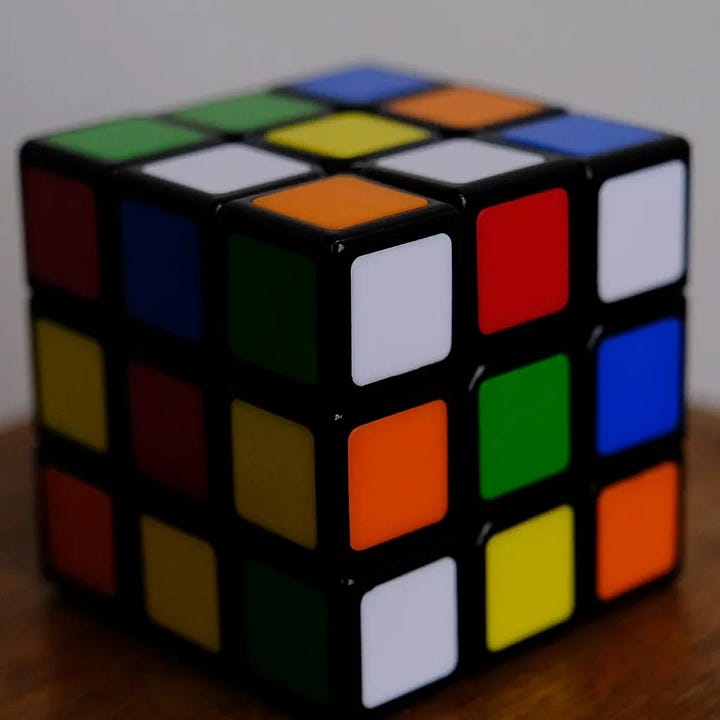

The world is made up of patterns. Some patterns are more meaningful than others. If a pattern is sufficiently meaningful we name it.
To demonstrate, we could look at color. Nowadays, every color has several technical names; some to be read by humans like ‘Quinacridone Magenta,’ others by computers like ‘#008000.’ But a small handful of names are the most important:
Red, orange, yellow, green, blue and purple.
These are always higher order categories in the taxonomy of hues. To understand why, we have to look again at color terms.
Color terms are interesting as they seem to be spaced arbitrarily. Look at how much of the light spectrum is green and how little of it is yellow. Look how apparently random the boundaries are. And yet they don’t feel random. Blurry though they are, they feel like natural and objective divisions.
But colors are not objective divisions of the light spectrum. You don’t consider blue and green different colors because they look different. You classify them this way because they mean different things. And it is possible, and indeed probable, that this amplifies the apparent difference.




In some languages, colors that are distinct in English are colexified. A common example is Vietnamese which uses a single word for both green and blue. You simply qualify the word or rely on context to make it clear which hue you actually mean.


Color terms appear to emerge in language not to describe physical facts, but rather, experiential ones. They are not truly divisions of the light spectrum, but rather, divisions of the human mind.
The same way you read these words automatically, you perceive colors automatically. Redness does not come from ‘out there’ in a simple, straightforward way. Just as these pixelated glyphs on your screen seem to contain sounds and meanings, a red thing seems to contain the intensity, warmth and vivacity of ripe fruit, blushing faces and hot metal. The color is not ‘associated’ with those things; it is those things.
Simply put: Color is not an optical phenomenon, it is a semiotic one.
A color is a phenomenological element with an intelligible and thus predictable structure. It is a kind of “object” that is spatially and temporally nonlocal, but nonetheless, coherent across instantiations; like a chemical element which has consistency but not particularity.
Our language, just like our mathematics, is a map of these rarefied strands of cosmic intelligence called teleological objects.
They can be represented mathematically, linguistically, visually, musically and probably lots of other ways as well. The only difference between a mathematical object and a teleological object of another sort is that the other kinds are harder to describe exactly, but this is due to the limits of both language and we who speak it.
The qualitative difference between a symphony and a rock song has the same ontological basis as the difference between two colors, which is ultimately no less human in origin than a quantitative distinction. (The act of recording quantities at all entails the existence of some agent who intends to use numbers for a biologically and qualitatively grounded purpose.)
The two pieces of music below demonstrate the principle.
It would be a mistake to suppose that the first song could serve well as theme music for a villain and the second for a hero. Again, there is a degree of flexibility in that there are numberless possible compositions which could serve either function in a story. But there is a consistency to the hero’s theme and the villain’s theme as such.
My other go-to example is Holst’s Mars vs. Dvorak’s Symphony No. 9. I can’t imagine anyone having a hard time telling which piece works better in which place.
What makes a given composition ‘sound bright’ or ‘sound dark’ is not arbitrary (ambiguous exceptions to the rule notwithstanding).
We create color terms because we correlate certain high-order elements of experience with the colors. We then express them in language and symbolism.
Red, for example, is the color of blood and fire, which indicate danger. Red is also the color of sexual arousal, as part of the natural human response to sexual stimuli is vasocongestion in the skin which causes faces to blush and lips to redden. Thus, red ultimately becomes the color of intensity in a way that becomes self-sustaining.
We convey this transcendental meaning using expressions like ‘with a fiery passion’ or ‘my blood burned.’



The connection is so strong and persistent that we make it instinctively. We have co-evolved with it. This is why stop signs, notifications, fast food logos, ‘sale’ stickers and lipstick are all red — red activates the sympathetic nervous system more than other colors. It grabs your attention. This technologization of the color as a symbol and cultural signal causes the association to become even stronger.
Because of this, such associations — though perhaps loose in the beginning — harden through compaction into fixed features of the environment. The teleological object is immanentized. If there was ever a time when red could have meant something else, that time has long since passed.
When these signals begin to be used arbitrarily, particularly as devices to cunningly extend one’s influence (as with virtue-signaling, ingratiation, money printing, propaganda and rote ritualism) they become glossalized instruments that occult and obfuscate instead of reveal. Every kind of deceit involves the exploitation and consequent debasement of meaningful signals in some way, shape or form.
Now, even more fundamental than color are verticality and horizontality.
Lines are not like the multipolar color spectrum, they’re like the white black spectrum, which is bipolar. Vertical and horizontal feel absolute. Diagonals are just the lines that don’t. What creates this contrast is that our minds have correlated these absolutes with different types of experience.
If we wanted to, we could say that there are seven types of lines, or five types of lines, or one type of line. You could assert quite persuasively that a line is just a line and its orientation does not matter.
Why don’t we do that?
Besides the fact that we need to describe things; because there is a real difference between verticality horizontality. Not a theoretical difference, but a practical one.
That difference is gravity.
Horizontal movement is not restricted in the same way that vertical movement is. To get from point A to point B, C, D or E, all other things being equal, requires an equal amount of energy. To cross the exact same distance to point F, however, will require a good deal more. This contrast between horizontal equality and vertical inequality is the reason that verticality is the axis of hierarchy — of inequality itself.
It is easier to fall down than it is to get back up; verticality is asymmetric in a way that horizontality is not. This is why the equals sign is horizontal and why you put the most important things at the top of a list.
Thus, in the taxonomy of color, red is the ‘high-order’ category while maroon, burgundy, crimson, garnet and scarlet are on a horizontal plane under it.
The vertical is the Jovian thunderbolt which names a thing and marks the center around which it turns. These, symbolically, are the same action. The horizontal is the Saturnine serpent which stretches a thing to its outermost limit.
The vertical, archetypally, is a wall or tower. Something that imposes a constraint, like a law. The horizontal — the axis usually used to represent time and any kind of spectrum — represents a boundary of possibility. It delimits a space in which things can exist. This is why the center of a city or castle usually has the tallest structures, and the edge of the city or castle is the fluidic place where things enter and exit.
It is also why the sun moves across the sky horizontally from East to West. We intuitively understand that the horizontal is the axis of change, movement and revolution. The vertical is the axis of fixity. This symbolism is the reason the terms ‘pole’ and ‘equator’ are used.
This structure which I use everywhere is already secretly implicit in the way we speak. The teleological object is made out of points. A point is a purpose towards which things move. When you’ve gotten the point of each set of events, you can see what they’re all pointing to and find out what the story was about.
The word vertex, another cousin of vertical, refers to the point of a geometric shape. It is a Latin term which can also mean whirl, vortex, the crown of the head, the pole of the heavens or the summit of something.
Even the color associations are deeply rooted in the symbolism of the vertical and horizontal. The color red is at the horizontal end of the light spectrum where the waves are shallower, while the color blue is at the vertical end of the spectrum where the waves are steeper.
Thus, blue is vertical and red is horizontal.
But this is not just an intellectual thing. It applies directly to observable reality.



When the sun is at the crest of its ascent, the sky is blue. When it is on the horizon at sunrise and sunset, the sky is red. This is called Rayleigh scattering, and it happens because the longer wavelength of red light can travel father through the atmosphere. The same basic principle is also the reason dark, low, heavy bass radiates farther and passes through walls more easily than higher, more energetic frequencies.
If you look at stars in the universe, you will find in like manner that the blue ones are much rarer — that is, sparser — and far brighter than the red ones. These latter are dimmer, more common and more numerous.
We can see the same thing in the hues of galaxies. Distant galaxies are expanding away from us, causing the light they emit to become redshifted in transit. Since there are obviously more distant galaxies than close one, the result is an apparent rarity of blue light even at the cosmic scale.
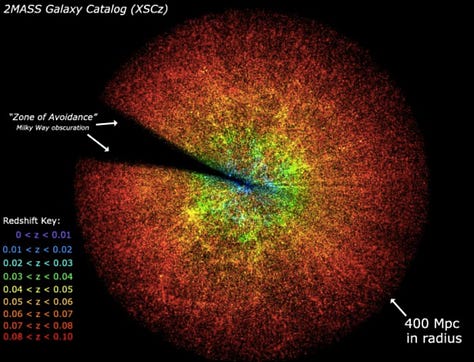
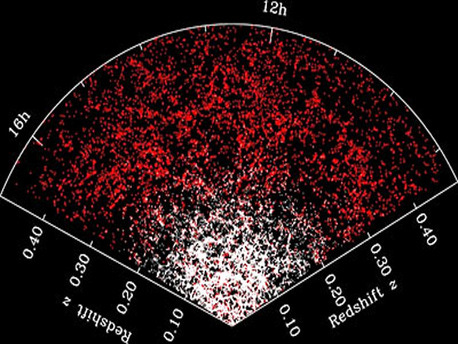

Following this same pattern, in ancient cosmologies, the lighter, more rarefied elements like fire and air are at the top of the pyramidal schema while heavier, denser elements like water and earth sink to the bottom.
The Language of Creation by Matthieu Pageau makes this same observation examining the statue in the dream of Nebuchadnezzar whose various metals also correspond to the classical elements:
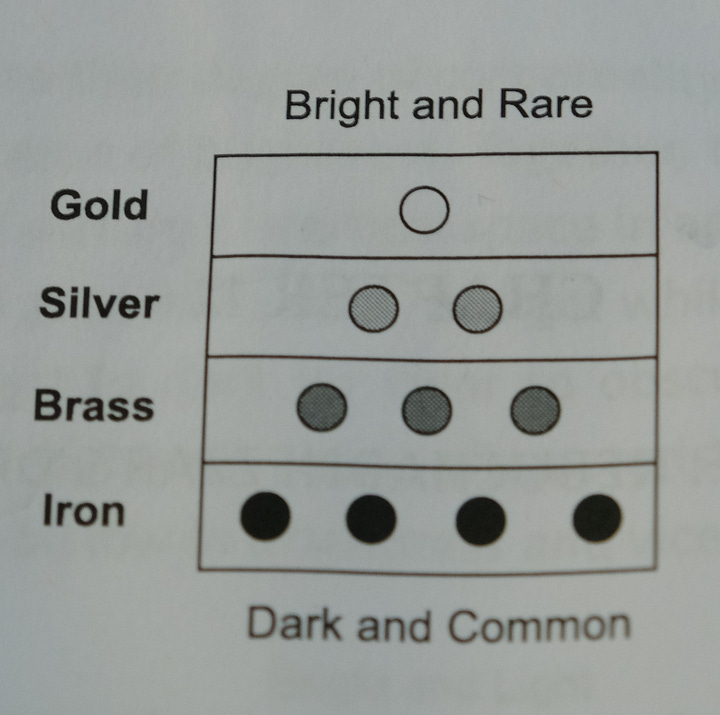
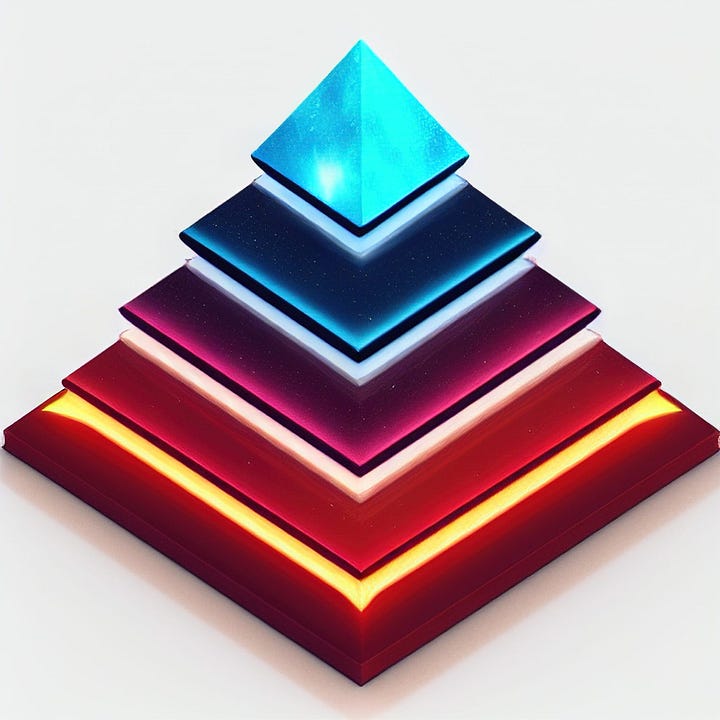
The vertical and horizontal and the relationship between the two is perhaps the most foundational and important key to this corpus of work and ancient symbolic systems in general. Since the video where I laid all of this out is no longer publicly available, I figured I should at least ensure that the information is.
Thank you for reading.






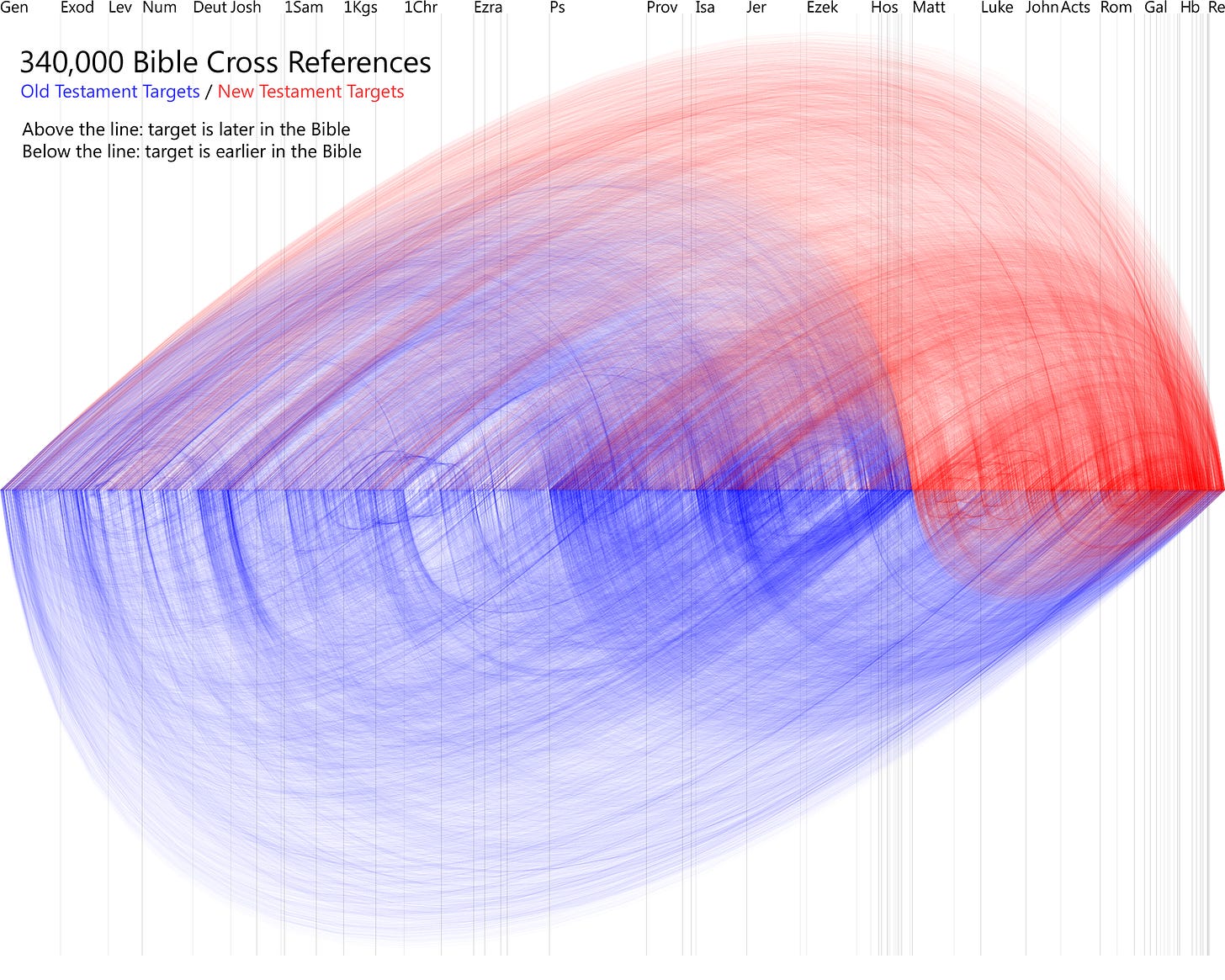


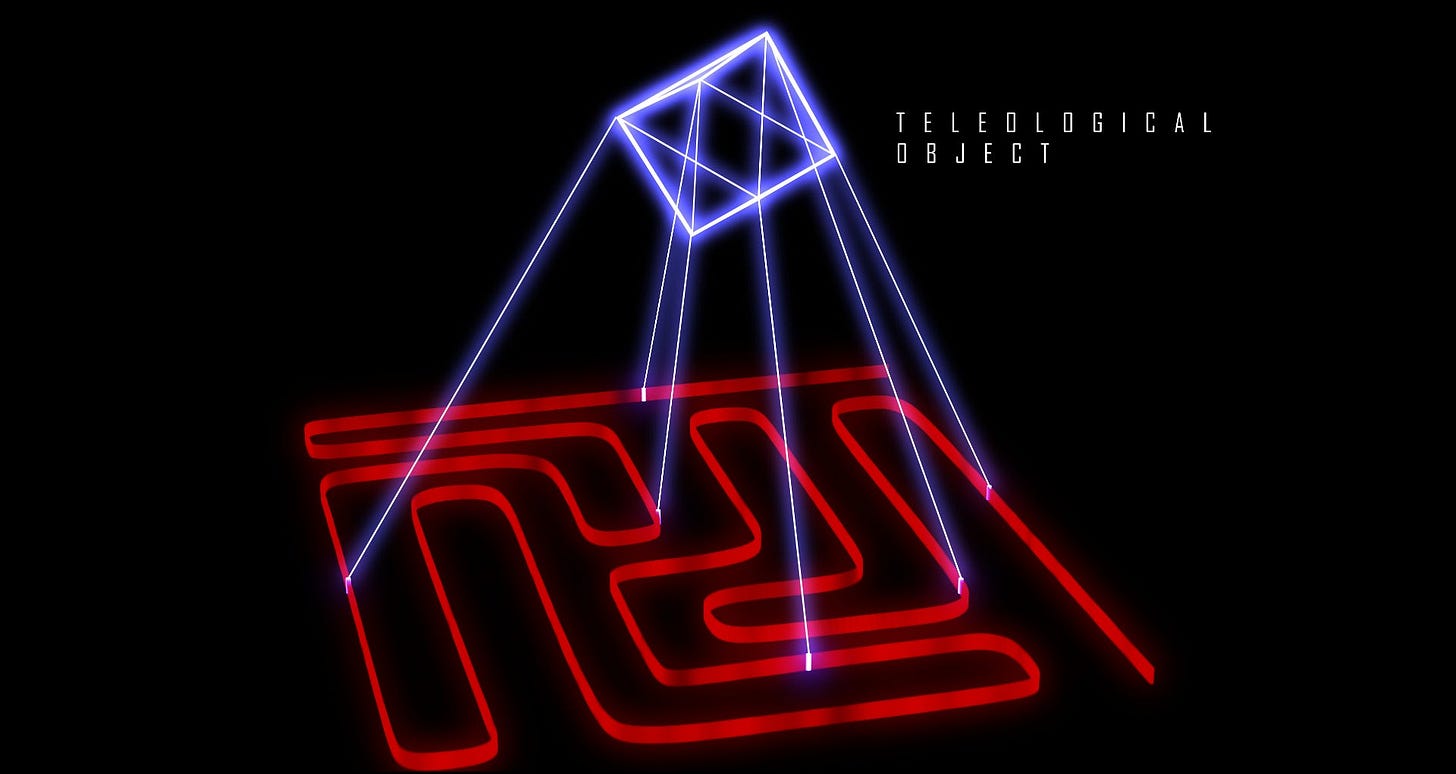


Hello. This is the first time I am commenting on this platform.
I hope you are doing well.
Long comment ahead:
I remember seeing The Shape of Everything from you 3+ years ago, and I still remember it vividly and how profoundly it affected me at the time. Heavy breathing, heart beating, strange clarity. It was my first exposure to your channel I got and to your content.
To say the least I got heavily invested because it was unlike anything I have ever heard before, and it didn’t feel disingenuous or like someone was trying to sell me an idea for some other motive than to spread the word.
I originally came to think that I had just viewed the video from another creator, but that clearly was not the case after some short evidence gathering. I questioned why you had removed it, but ultimately figured you had done it for a good reason, and it seemed to be correct mostly.
I came to download all of your videos around a while back directly after I noticed that the original video that introduced me to you was now inaccessible to me.
I notice you also have removed these videos, since I had them downloaded and they were not on your channel anymore:
The Bible’s Secret Messages
To Thy Pupil Cometh Sight
From Thy Shadow Cometh Light
And it is saddens me that you removed these, since even if you might look back at them and find imperfections too glaring, I still see it as profoundly interesting and eye opening.
I see it as the steps in your journey and the untarnished chapters of an authors original work.
And like the burning of the library of Alexandria, I can only feel loss of something that is worth sharing and keeping around.
I came to accept that I would never be able to see The Shape of Everything ever again. And then time passed and I went about my life once more.
It was only a few weeks ago that I returned to download some of your newer videos, to archive them in the event that those videos in the future would no longer be accessible anymore for any reason. I looked back at the videos I had archived that you had now made accessible, and I only wished that The Shape of Everything was available to watch, since I remember it with a strange yet profound fondness of sorts. It was the first introduction to your work, and I could see the value it held above most content on YouTube. I came to this platform to see your posts and to what you said, with a previous post talking about how you removed the video deliberately, which I felt was strange.
The urge to find the video once more was overwhelming, I even went as far as to rummage through the Wayback Machine to see earlier states of your channel to mixed results. I did not find it.
Funny how a few weeks after my fruitless pursuits, you would make this post.
I am glad to see you talking about it, let alone even adding more things to think about.
Regardless of how you feel about the original The Shape of Everything, I would still ask you to make it watchable again along with the other videos you made private. Or possibly upload all your videos somewhere other than YouTube for the sake of archiving them to the public to view.
Because I truly think they are worth keeping around.
Wish I could describe the weird synchronicity this was a part of… thanks for sharing this when you did!